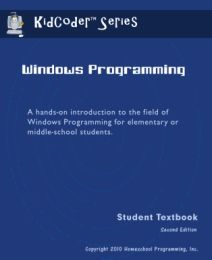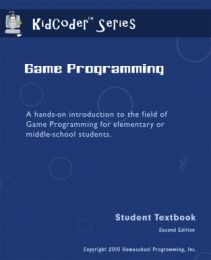
Homeschooling Programming was founded by homeschool parents who have over 17 years of experience in the software industry and hold a B.S. and M.S. degrees in Computer Science and Electrical Engineering. They wanted to use their love of computers and programming to teach and inspire a new generation by creating courses that would teach professional programming language for students in a fun way that non-technical parents would be able to teach. Over the last several weeks, I have had an opportunity to use and review the Kid Coder Visual Basic Series with my 6th grade son.


The Kid Coder Visual Basic series is deigned for 6th-8th grade students. These are self study courses that use the Visual Basic programming language. Visual Basic is used in a wide variety of academic and business settings in the world today. There are two different courses in the Kid Coder Visual Basic series which are each designed to take a semester to complete. The Kid Coder Windows Programming course is the first semester. The Windows Programming course teaches students to write graphical Windows programs using Visual Basic. The second semester course is called Game Programming in which students will learn to write several different games while learning game programming techniques. You must complete the Windows Programming course before moving on to Game Programming. No prior programming experience is necessary before starting these courses, although students should know the basics of using a computer and a keyboard, and how to find, open, and save files. Each course comes with activity solutions, tests and answers, and a Solution Guide. Students can complete the course independently and move at their own pace. To use the Kid Coder Visual Basic series, you need to have a Windows Computer with a CD Rom. You can see the complete computer requirements by clicking here.
You can view sample pages by clicking here.
You can purchase each of the one semester courses(Windows Programming or Game Programming) for $70.00. You also have the option of buying the course with video instruction for $85.00. Or you have the option to buy both semesters together for a discounted price of $120 for the courses or $145 for the courses with the video instruction. You will receive a physical student textbook and CD that when run will install the course material on your computer and/or DVD if you purchase the optional video instruction.
In addition to the course material, you will need to download Microsoft Visual Basic 2010 Express to your computer. This software is free to download and use. Instructions on how to download and get started with this software is included in the course instruction materials.
I have been using the Kid Coder Visual Basic Series with Nicholas who is 11 year old and has just started 6th grade. For the purpose of this review, we received a PDF version of the text and a download version of the course. Instead of printing out the text or trying to read it while working on the computer, I loaded the PDF on the iPad for Nick to read off of. He completed a chapter a week of the Windows Programming course. There is a total of 14 chapters in the course. Chapters Include: Introduction to Computers, Get Your Feet Wet, Exploring Visual Basics Programs, Data Types and Variables, Basic Flow Control, Getting User Input, Working With Numbers, Working With Strings, using the Debugger, Loops in Programs, Functions, Arrays and Structures, Distributing Your Programs, and Putting It Altogether. Each chapter contains 3-4 lessons, a chapter review and a Your Turn activity. The length of each lesson varies. The chapter review is one page of bullet points highlighting the important things that you learned in the chapter. The Your Turn activity is a practice opportunity to use the main skill that you learned in the chapter.
I admit that computer programming intimidates me. . . a lot. But I thought that it would be something that Nick would be interested in and a good skill for him to learn. We had no trouble at all downloading and getting started with this program, or downloading the Microsoft Visual Basic 2010 Express. The hardest part was the free registration of the Microsoft VB 2010 Express, but Kid Coder even explained that step by step and we had no trouble. Because Nick is on the younger end of the age range, I started out reading over the sections ahead of time and once we got the Microsoft Visual Basic downloaded, I did the first few assignments to make sure I could and so I could help him if he had problems. But, as I was practicing one of the first lessons, he happened to be sitting near me on the couch. He took the computer, read through the section and followed it with no trouble. Much faster than I had. That ended my practice sections, although I did continue to sit with him as he worked so I could see what he was doing and help if I could.
 |
| orange and blue are his favorite colors and he enjoyed customizing this program |
The Game Programming second semester course is set up just like the Windows Programming course. You do need to complete the first semester course before beginning the Windows Programming. The lessons are a little more in depth and many times there multiple "your turn" activities for the student to practice their skills. The course contains 14 chapters with 3 to 5 lessons in each chapter. The Game Programming course will build on previous skills that your child has learned and teach them how to write their own computer games. It begins with a brief review of the first semester materials, discussion of the different types of computer games, and then moves on into the installation of the software. The following chapters include: Game Design, Drawing on the Screen, User Input, Graphics In Visual Basic, Images and Animation, Sprites, Game Logic, Sound, Artificial Intelligence, Saving Your Games, Game Physics, Drawing Text and Printing, and a Final Project. We have not yet completed the Windows Programming course, but when Nick does I think he will enjoy moving on and learning to write computer games.
Homeschool Programming has succeeded in their goal to create programming courses for children that even those with no programming experience can do. Members of The Crew reviewed the Kid Coder Visual Basic Series, Kid Coder Web Series, Teen Coder C# Series, and TeenCoder Java Series. To see what my Crew Mates had to say, click on the banner below.



No comments:
Post a Comment